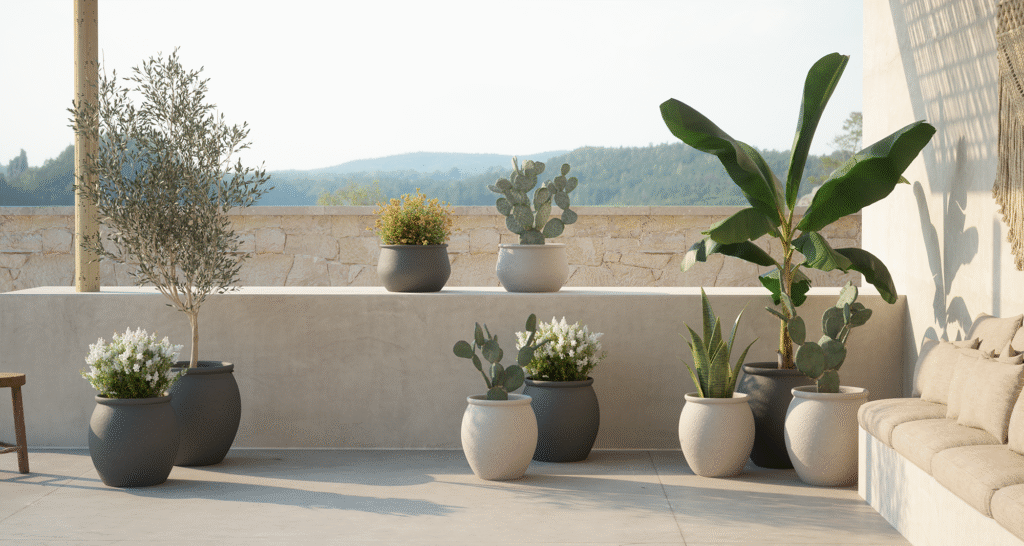Succulent care is essential for helping your plants thrive in the long term. While watering and soil often get the most attention, proper light exposure and temperature management are just as crucial. Different types of succulents have varying preferences—some enjoy full sun, others prefer partial shade. Similarly, some tolerate cooler temperatures, while others need consistent warmth.
Whether you’re in Belgium, the Netherlands, or a similar climate, knowing the light and temperature needs of each succulent type will help you create the right environment indoors or outdoors. In this guide, we’ll explore how to adapt your setup and care routine to keep your succulents healthy, colorful, and resilient.
Why Understanding Succulent Light and Temperature Needs Matters
Succulents are native to various climates, from arid deserts to alpine forests. Each type has evolved to thrive under specific light and temperature conditions. While they are low-maintenance, ignoring their environmental needs can lead to stunted growth, wilting, or rot. Ensuring the right care isn’t just about survival—it’s about helping your succulents truly thrive.

Indoor vs. Outdoor Succulent Care
Light Requirements Indoors
Succulents grown indoors in Belgium and the Netherlands face unique challenges due to limited daylight during the winter months.
-
Place near south-facing windows for optimal sunlight.
-
Use grow lights to supplement natural light from October to March.
-
Rotate pots weekly to prevent lopsided growth.
Temperature Guidelines Indoors
Most succulents prefer:
-
Daytime temperatures: 20–25°C
-
Nighttime temperatures: 10–15°C
Avoid placing them near radiators or drafty windows, as sudden temperature shifts can stress the plant.
Outdoor Succulent Care
In the summer, succulents can enjoy the outdoors. Place them on balconies, terraces, or gardens with filtered sunlight.
-
Acclimate them gradually to direct sunlight to prevent sunburn.
-
Bring them indoors once temperatures drop below 8°C.
Succulent Care by Type
Each variety has its quirks. Below, we break down the most popular types and how to care for them.
Echeveria
Light Needs
-
Full sun to partial shade.
-
Needs at least 6 hours of bright, indirect light daily.
Temperature Tolerance
-
Prefers 15–26°C.
-
Protect from frost—bring indoors during cold months.
Care Tips
-
Avoid water sitting in the rosette to prevent rot.
-
Use well-draining soil and containers with drainage holes.
Haworthia
Light Needs
-
Low to medium light.
-
Thrives in indirect sunlight or shaded areas.
Temperature Tolerance
-
Stable room temperature between 18–24°C.
-
Tolerates cooler nights but avoid frost.
Care Tips
-
Ideal for indoor settings.
-
Water every 2–3 weeks in winter, weekly in summer.
Crassula (Jade Plant)
Light Needs
-
Loves bright light, but not direct midday sun.
-
Can grow leggy in low light.
Temperature Tolerance
-
Best between 18–24°C.
-
Can survive cooler nights but must be frost-free.
Care Tips
-
Let the soil dry completely between waterings.
-
Needs repotting every 2–3 years due to slow growth.
Aloe Vera
Light Needs
-
Needs bright, direct sunlight.
-
Benefits from being placed in a sun-drenched corner.
Temperature Tolerance
-
Ideal: 19–27°C.
-
Minimum: 10°C (below this, growth halts).
Care Tips
-
Water deeply but infrequently.
-
Excellent for sunny kitchen windows.
Sedum (Stonecrop)
Light Needs
-
Tolerates full sun.
-
Minimum 4 hours of sunlight daily.
Temperature Tolerance
-
Cold-hardy—can tolerate down to -5°C in dry conditions.
Care Tips
-
Perfect for outdoor rock gardens.
-
Avoid excess moisture in colder months.
Best Practices for Managing Light and Heat
Even with the right general tips, there are universal practices every succulent owner should follow.
Best Light Practices
-
Observe the plant—stretching = not enough light.
-
Leaf discoloration often signals overexposure.
-
Use mirrors or white walls to reflect more light onto plants.
Managing Indoor Temperature
-
Keep away from radiators and heat vents.
-
Use a digital thermometer for consistency.
-
Avoid cold drafts near doors and windows.
Summer vs. Winter Adjustments
| Season | Light Advice | Temperature Tip |
|---|---|---|
| Summer | Protect from harsh midday sun | Ensure ventilation |
| Winter | Use grow lights for supplement | Avoid cold window sills |
Common Signs Your Succulent Needs Help
Stay vigilant. Early signs of stress can be reversed with proper care.
-
Pale leaves: Lack of light
-
Wrinkled leaves: Underwatering
-
Mushy stem: Overwatering or cold damage
-
Stretching upwards: Not enough sunlight
Tips for Belgian and Dutch Households
The Northern European climate offers both challenges and advantages for succulent care.
-
Use insulated window sills to prevent cold exposure.
-
Invest in LED grow lights for dark winters.
-
Choose compact, low-light species like Haworthia or Gasteria for apartments with minimal sun.
Why Buy from Succulux.be?
At Succulux.be, we specialize in providing high-quality, hand-picked succulents tailored for Belgian and Dutch climates. Whether you’re a beginner or a seasoned plant parent, you’ll find species that suit your living space, backed by expert care instructions. Our plants are locally sourced, carefully packaged, and delivered fast across Belgium and the Netherlands. It’s no wonder we’re the top-rated platform for succulent lovers in the region.
Final Thoughts on Succulent Care
Caring for succulents is simple once you understand their needs. Proper light and temperature management will ensure your plants not only survive but thrive. With the right positioning, attention, and seasonal adjustments, your succulents will remain vibrant year-round.
For more guides and premium succulents, visit Succulux.be—your trusted source for all things green and beautiful.


